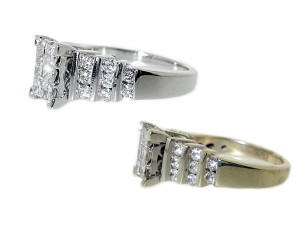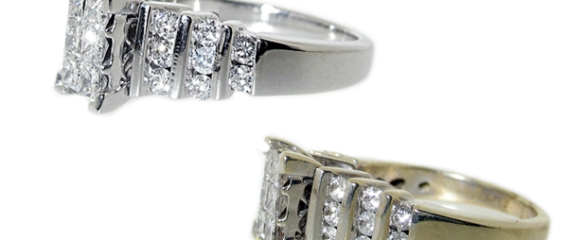What is White Gold, and why does it have to be Rhodium Plated?
GOLD:
Gold is an element and a precious metal and it is always yellow. There is no such thing as an isotope of gold that is white. But jewelry is not usually made from pure 24 kt gold because it’s very soft. Gold rings and jewelry are usually made from an alloy of gold plus other metals:
– 14 kt gold is 14/24ths gold and 10/24ths other metals,
– 12 kt gold is 12/24ths gold and 12/24ths other metals,
– 10 kt gold is 10/24ths gold and 14/24ths other metals.
At the risk of slight simplification, if the “other metals” are copper or silver the gold will remain yellow, whereas if the “other metals” are palladium and/or nickel you get white gold.
Nickel is much cheaper than palladium, so it is widely used in white gold jewelry in the U.S.. But so many people are allergic to nickel that it is forbidden in jewelry in Europe, and palladium would be used there instead.
RHODIUM:
Rhodium is also a precious metal. In fact, it’s about ten times costlier than gold! But it is generally not considered a feasible material to make solid jewelry from because it is stressed and brittle, is very difficult to “work” properly for jewelry making, and it’s price is very volatile (sometimes it’s 5x as costly as gold, sometimes 25x) But rhodium is fabulous as a plating for jewelry because it is glitteringly, dazzlingly, white and mirror-like. It’s like chrome, only more so, and much whiter.
**Rhodium plating makes diamonds look bigger and better because it’s so bright that it’s hard to see where the stones end and the metal begins. Nothing sets off diamonds like rhodium plating does — but it is only a plating and therefore it will wear off and require replating.
HOW LONG WILL RHODIUM PLATING LAST?
No matter how well white gold is made, a metal which is about half gold (which is yellow) will eventually lose its bright white color and need to be re-rhodium plated.
This is the big question, but the answer isn’t easy. First, it depends on whether it’s a ring (rings suffer a great deal of wear), or a pin or broach which receives almost no contact. And it depends on whether you wear the ring constantly. To some extent it also depends on that old bugaboo “body chemistry”. But it also depends on two other very important and controllable factors —
1)How good is the quality of the plating
2)What color is the underlying gold
**We at MacPherson’s use the highest quality rhodium available**

Information in this blog is based off information from the following website: http://www.finishing.com/faqs/whitegold.shtml






















